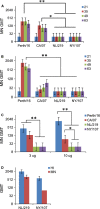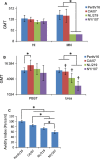Recombinant influenza H7 hemagglutinins induce lower neutralizing antibody titers in mice than do seasonal hemagglutinins
- PMID: 25213778
- PMCID: PMC4262278
- DOI: 10.1111/irv.12285
Recombinant influenza H7 hemagglutinins induce lower neutralizing antibody titers in mice than do seasonal hemagglutinins
Abstract
Background: Vaccines against avian influenza viruses often require high hemagglutinin (HA) doses or adjuvants to achieve serological titers associated with protection against disease. In particular, viruses of the H7 subtype frequently do not induce strong antibody responses following immunization.
Objectives: To evaluate whether poor immunogenicity of H7 viruses is an intrinsic property of the H7 hemagglutinin.
Methods: We compared the immunogenicity, in naïve mice, of purified recombinant HA from two H7 viruses [A/Netherlands/219/2003(H7N7) and A/New York/107/2003(H7N2)] to that of HA from human pandemic [A/California/07/2009(H1N1pdm09)] and seasonal [A/Perth16/2009(H3N2)] viruses.
Results: After two intramuscular injections with purified hemagglutinin, mice produced antibodies to all HAs, but the response to the human virus HAs was greater than to H7 HAs. The difference was relatively minor when measured by ELISA, greater when measured by hemagglutination inhibition assays, and more marked still by microneutralization assays. H7 HAs induced little or no neutralizing antibody response in mice at either dose tested. Antibodies induced by H7 were of significantly lower avidity than for H3 or H1N1pdm09.
Conclusions: We conclude that H7 HAs may be intrinsically less immunogenic than HA from seasonal human influenza viruses.
Keywords: H7 influenza viruses; hemagglutinin; immunogenicity; influenza; influenza pandemics; influenza vaccines.
© 2014 The Authors. Influenza and Other Respiratory Viruses Published by John Wiley & Sons Ltd.
Figures




Similar articles
-
Inactivated H7 Influenza Virus Vaccines Protect Mice despite Inducing Only Low Levels of Neutralizing Antibodies.J Virol. 2017 Sep 27;91(20):e01202-17. doi: 10.1128/JVI.01202-17. Print 2017 Oct 15. J Virol. 2017. PMID: 28768855 Free PMC article.
-
Seasonal influenza vaccination is the strongest correlate of cross-reactive antibody responses in migratory bird handlers.mBio. 2014 Dec 9;5(6):e02107. doi: 10.1128/mBio.02107-14. mBio. 2014. PMID: 25491354 Free PMC article.
-
Optimal designs of an HA-based DNA vaccine against H7 subtype influenza viruses.Hum Vaccin Immunother. 2014;10(7):1949-58. doi: 10.4161/hv.28795. Hum Vaccin Immunother. 2014. PMID: 25424804 Free PMC article.
-
L226Q Mutation on Influenza H7N9 Virus Hemagglutinin Increases Receptor-Binding Avidity and Leads to Biased Antigenicity Evaluation.J Virol. 2020 Sep 29;94(20):e00667-20. doi: 10.1128/JVI.00667-20. Print 2020 Sep 29. J Virol. 2020. PMID: 32796071 Free PMC article.
-
Engineered Nanoparticle Applications for Recombinant Influenza Vaccines.Mol Pharm. 2021 Feb 1;18(2):576-592. doi: 10.1021/acs.molpharmaceut.0c00383. Epub 2020 Aug 17. Mol Pharm. 2021. PMID: 32787280 Free PMC article. Review.
Cited by
-
Maternally-Derived Antibodies Protect against Challenge with Highly Pathogenic Avian Influenza Virus of the H7N3 Subtype.Vaccines (Basel). 2019 Oct 30;7(4):163. doi: 10.3390/vaccines7040163. Vaccines (Basel). 2019. PMID: 31671571 Free PMC article.
-
Virus-Mimicking Cell Membrane-Coated Nanoparticles for Cytosolic Delivery of mRNA.Angew Chem Int Ed Engl. 2022 Jan 10;61(2):e202113671. doi: 10.1002/anie.202113671. Epub 2021 Nov 29. Angew Chem Int Ed Engl. 2022. PMID: 34694684 Free PMC article.
-
Antibody Immunity Induced by H7N9 Avian Influenza Vaccines: Evaluation Criteria, Affecting Factors, and Implications for Rational Vaccine Design.Front Microbiol. 2017 Sep 26;8:1898. doi: 10.3389/fmicb.2017.01898. eCollection 2017. Front Microbiol. 2017. PMID: 29018438 Free PMC article.
-
Inactivated H7 Influenza Virus Vaccines Protect Mice despite Inducing Only Low Levels of Neutralizing Antibodies.J Virol. 2017 Sep 27;91(20):e01202-17. doi: 10.1128/JVI.01202-17. Print 2017 Oct 15. J Virol. 2017. PMID: 28768855 Free PMC article.
-
Induction of protective immunity against influenza A/Jiangxi-Donghu/346/2013 (H10N8) in mice.J Gen Virol. 2017 Feb;98(2):155-165. doi: 10.1099/jgv.0.000683. Epub 2017 Mar 13. J Gen Virol. 2017. PMID: 27983474 Free PMC article.
References
-
- Bosch FX, Garten W, Klenk HD, Rott R. Proteolytic cleavage of influenza virus hemagglutinins: primary structure of the connecting peptide between HA1 and HA2 determines proteolytic cleavability and pathogenicity of Avian influenza viruses. Virology. 1981;113:725–735. - PubMed
-
- Koopmans M, Wilbrink B, Conyn M, et al. Transmission of H7N7 avian influenza A virus to human beings during a large outbreak in commercial poultry farms in the Netherlands. Lancet. 2004;363:587–593. Epub 2004/02/28. - PubMed
Publication types
MeSH terms
Substances
Associated data
- Actions
LinkOut - more resources
Full Text Sources
Other Literature Sources
Medical

